The 1996 half dollar is part of the Kennedy half dollar series that was first issued by the US Mint in 1964, a year after the assassination of John F. Kennedy, the 35th president of the United States.
As you can imagine, the 1996 Kennedy half dollar is rich in history. Thus, you might consider completing your collection of all Kennedy half dollars today. If yes, then you should never miss the 1996 50-cent.
Continue reading and discover the value, composition, history, and design of the 1996 Kennedy half dollar.
What Is the 1996 Kennedy Half Dollar Made Of?
The composition of a coin directly affects its value. So, it’s worth knowing what the 1996 Kennedy half dollar is made of.
The 1996 Kennedy half dollar is composed of 75 percent copper and 25 percent nickel. Its value is 50 cents with a mass of 11.30 grams and a diameter of 30.61 millimeters.
There were two designers of the Kennedy half dollar —for the obverse, Gilroy Roberts, and for the reverse, Frank Gasparro. Their designs were based on their earlier work since they didn’t have enough time to create new ones.
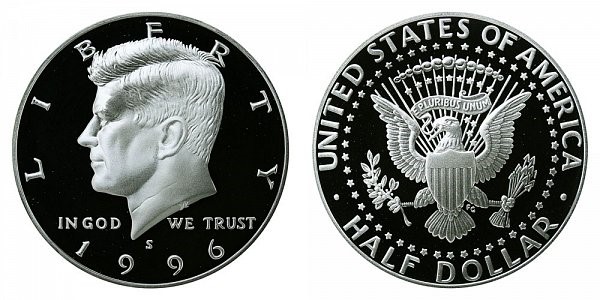
For the obverse, you’ll find the bust of John Kennedy, facing to the left. Inscriptions include LIBERTY, IN GOD WE TRUST, mint mark (if present), and 1996.
You’ll find the heraldic eagle holding an olive branch and arrows for the reverse. You’ll find a banner on its beak that says, “E PLURIBUS UNUM.” Inscriptions include the UNITED STATES OF AMERICA and HALF DOLLAR.
One of the darkest moments in the history of the United States was when its then-president, Kennedy, was shot dead on November 22, 1963. From there, there were serious considerations about placing Kennedy’s portrait on one of the silver coins. Later, the half-dollar coin was chosen since Mrs. Kennedy didn’t want to replace the portrait of Washington on the quarter dollar.
One thing that could have prevented the creation of a new Kennedy half dollar was that according to existing law at that time, a coin design should last at least 25 years before replacing it. The Franklin half dollar was only 15 years old. However, due to the unanimous decision of Congress to add Kennedy to the coin, the Act of 1963 was passed, and the US Mint was set to issue Kennedy half dollars in the following year.
When the first Kennedy half dollars went into circulation, it was so popular that many people didn’t want to spend their newly acquired coin. As a result, widespread hoarding led to the Kennedy half-dollar shortage. The US Mint increased its production but to no avail.
Later, the solution seen by the US Mint was to remove the silver content of the Kennedy half dollar. Today, the Kennedy half dollar has become a popular US coin cherished locally and abroad.
1996 Kennedy Half Dollar Varieties
There are four varieties of the 1996 Kennedy half dollar. These are the following:
| Variety | Mint Location | Mintage |
| 1996 P Kennedy Half Dollar | Philadelphia | 24,442,000 |
| 1996 D Kennedy Half Dollar | Denver | 24,744,000 |
| 1996 S Proof Kennedy Half Dollar | San Francisco | 1,750,244 |
| 1996 S Silver Proof Kennedy Half Dollar | San Francisco | 775,021 |
| Total | 51,711,265 |
The Philadelphia and Denver Mint produced the regular coins, while the San Francisco Mint produced the proof coins. The US Mint also produced special Kennedy silver proof coins in 1996.
Aside from the regular coins struck in the Philadelphia and Denver Mints, the San Francisco issued proof coins and silver proof coins. At the end of 1996, the US Mint produced more than 51 million half dollars.
Let’s now take a deeper look at each of the 1996 Kennedy half dollar varieties:
1996 P Kennedy Half Dollar
Year of minting: 1996
Mint Mark: P
Place of minting: Philadelphia
Quantity produced: 24,442,000
Face Value: $0.50 (fifty cents)
Price: $0.60 to $0.75 (circulated condition)
Mass: 11.30 grams
Diameter: 30.61 millimeters
Edge: Reeded
Designer: Gilroy Roberts/Frank Gasparro
Composition: 75% Copper, 25% Nickel
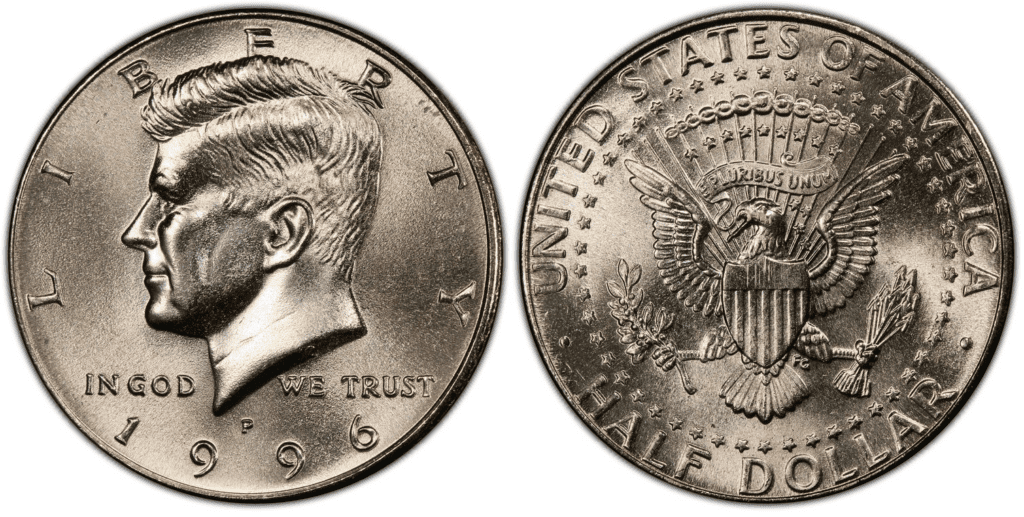
The 1996 Kennedy half dollar should be easy to find in grades up to MS66 condition. Although 1996 half-dollar coins in grades MS67 are difficult to find, you might find some in bags, sets, and rolls with more time and effort.
1996 D Kennedy Half Dollar
Year of minting: 1996
Mint Mark: D
Place of minting: Denver
Quantity produced: 24,744,000
Face Value: $0.50 (fifty cents)
Price: $0.60 to $0.75 (circulated condition)
Mass: 11.30 grams
Diameter: 30.61 millimeters
Edge: Reeded
Designer: Gilroy Roberts/Frank Gasparro
Composition: 75% Copper, 25% Nickel
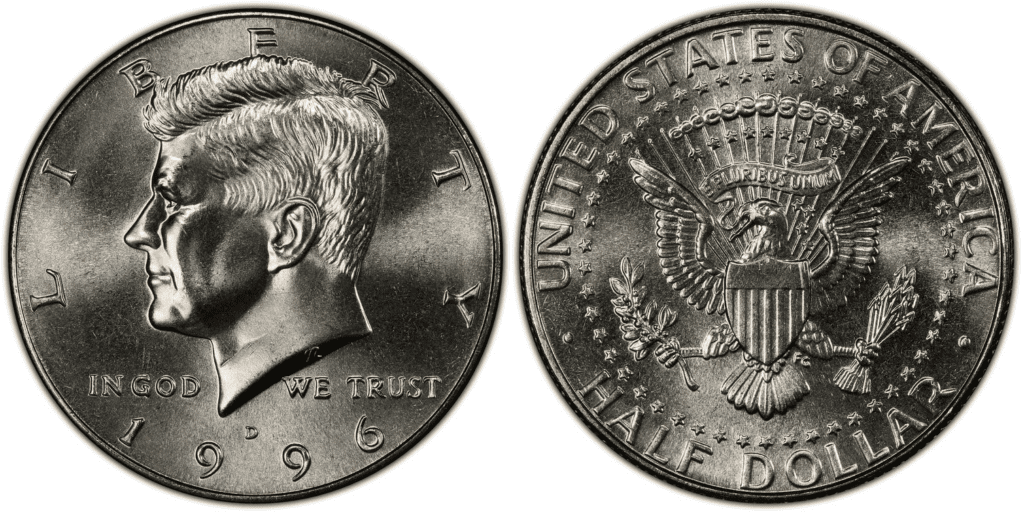
Like the 1996-P Kennedy half dollar, you can find the 1996-D in grades up to MS66. You can still find them in MS67 and MS68 grades but with more effort.
1996 S Kennedy Half Dollar
Year of minting: 1996
Mint Mark: S
Place of minting: San Francisco
Quantity produced: 1,750,244
Face Value: $0.50 (fifty cents)
Price: $13 or above (uncirculated condition)
Mass: 11.30 grams
Diameter: 30.61 millimeters
Edge: Reeded
Designer: Gilroy Roberts/Frank Gasparro
Composition: 75% Copper, 25% Nickel
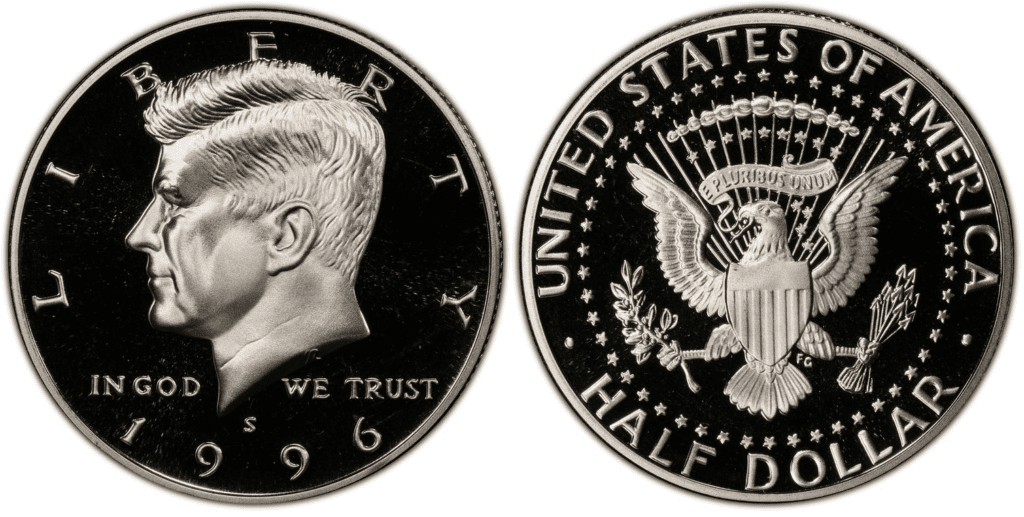
The San Francisco Mint produced more than 1.7 million proof coins in 1996. The 1996-S half dollar coin was made with more precision and care than the regular coins.
1996 S Silver Kennedy Half Dollar
Year of minting: 1996
Mint Mark: S
Place of minting: San Francisco
Quantity produced: 775,021
Face Value: $0.50 (fifty cents)
Price: $13 or above (uncirculated condition)
Mass: 11.30 grams
Diameter: 30.61 millimeters
Edge: Reeded
Designer: Gilroy Roberts/Frank Gasparro
Composition: 75% Copper, 25% Nickel
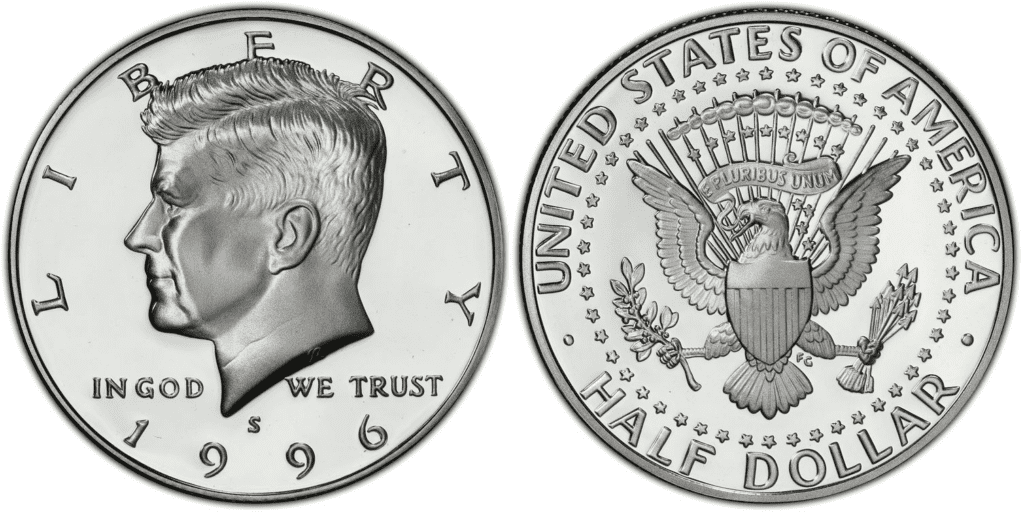
The San Francisco Mint produced a special 1996 Kennedy half dollar edition. This time, the Mint produced a silver proof coin, which is more valuable.
List Of 1996 Kennedy Half Dollar Errors
With the mass production of the 1996 Kennedy half dollar coins, some would inevitably come with errors. Although it may sound negative, many collectors are highly interested in error coins since they are unique and, sometimes, rare. Thus, it is unsurprising that some half dollar error coins are even more valuable than regular coins.
Here are some examples of 1996 Kennedy half dollar error coins:
Clipped planchet error
Most coin errors happen when the die strikes the coin. However, a clipped planchet error happens before the coin even gets the chance to hop into the hubbing machine.
A clipped planchet happens when there’s a misalignment between the cutting blade and the planchet. As a result, some portion of the coin is clipped or missing.
Here’s an example of a coin with two clipped areas:
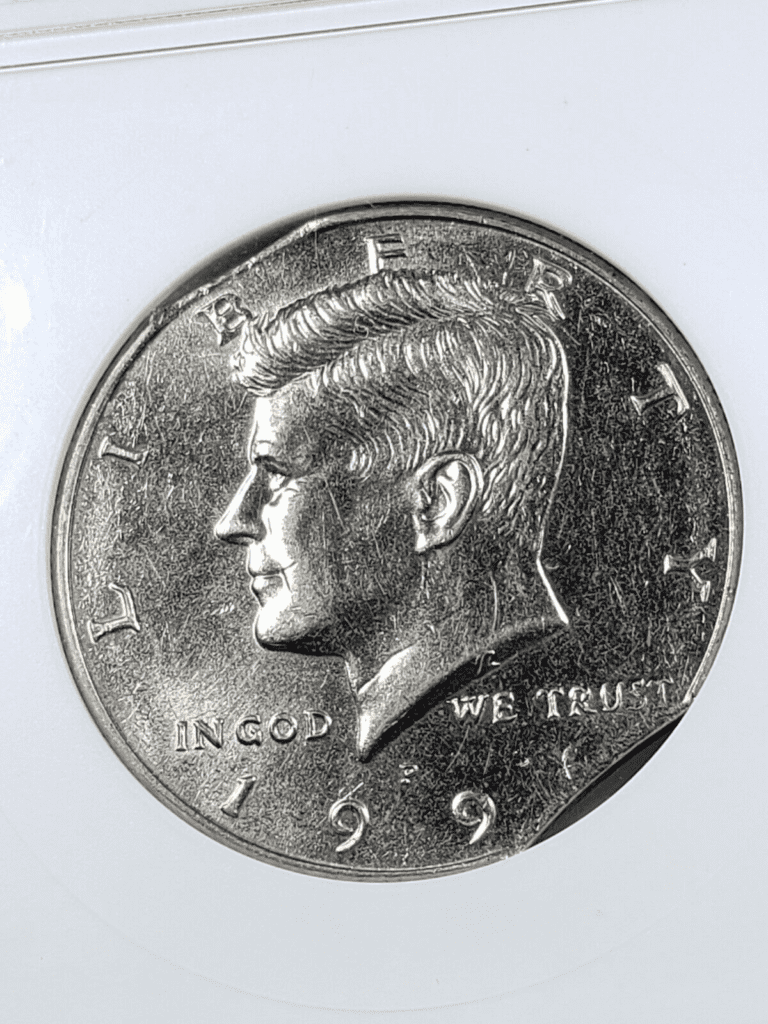
Die clash
Two dies are used to mint a coin — the obverse and reverse dies. Die clash happens when the two dies hit each other when there’s no planchet between them. The strong collision force can damage the die. Die clash would then cause some unintended marks on the coin.
Here’s what a die clash error looks like in a 1996 Kennedy half dollar:
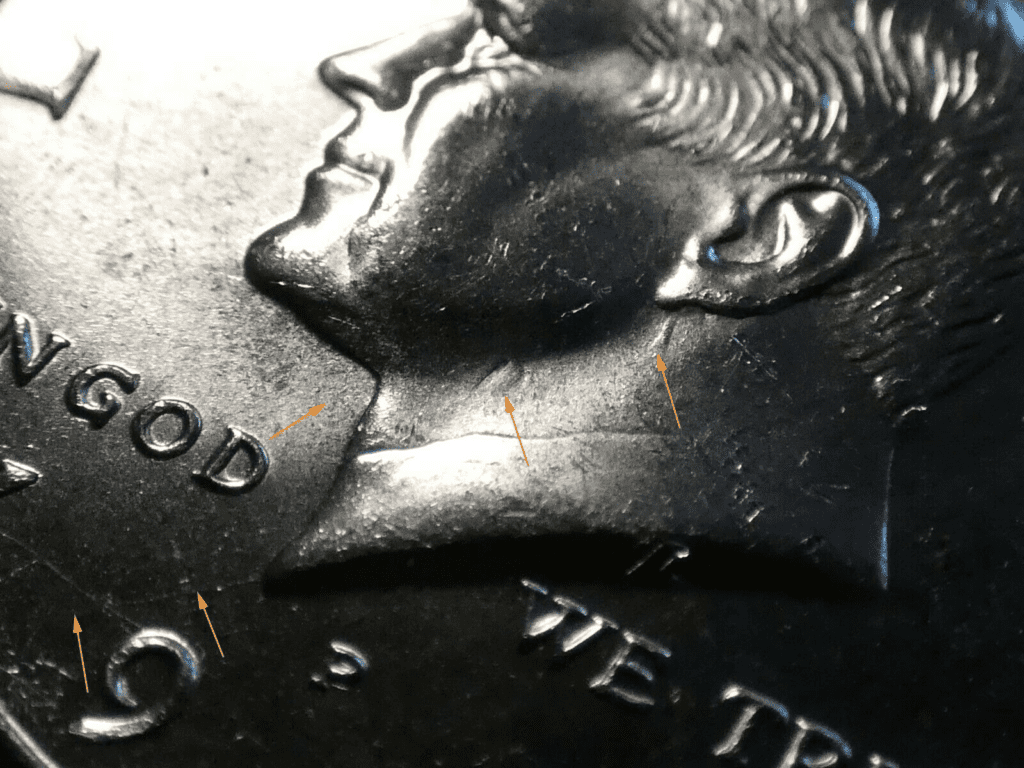
Die break error
Dies hit blank coins multiple times in a very short period. Due to wear and tear, the die could break and develop a crack. When the die hits the planchet, the crack would leave a mark on the coin’s surface.
Here’s an example of a die break error:

How Much Is the 1996 Kennedy Half Dollar Worth Today?
If you’re going to buy or sell a 1996 Kennedy half dollar, the biggest question you may have is about its value. The price of a coin depends on its rarity and condition. If it is both in superb condition and rare simultaneously, it can surely be worth a lot of money.
However, ordinary and regular 1996 Kennedy half dollars may be less than a dollar. The face value of the 1996 Kennedy coin is just 50 cents. The melt value is just $0.1154. The melt value of the 1996 Kennedy half dollar silver proof coin is higher, which is $7.6571, due to its silver content.
With this in mind, you’ll be surprised that there are some 1996 Kennedy half dollar coins worth several hundred or thousands of dollars.
Here’s a table to show you the auction records of half-dollar coins:
| Coin | Condition | Grade | Sold date | Sold by | Value |
| 1996 P Kennedy Half Dollar | Superb Gem Uncirculated | MS 68 | October 3, 2018 | Heritage Auctions | $432 |
| 1996 D Kennedy Half Dollar | Superb Gem Uncirculated | MS 68 | August 5, 2014 | Heritage Auctions | $1,293 |
| 1996 S Proof Kennedy Half Dollar | Perfect Uncirculated | PR 70 – Deep Cameo | September 1, 2003 | Heritage Auctions | $2,185 |
| 1996 S Silver Proof Kennedy Half Dollar | Perfect Uncirculated | PR 70 – Deep Cameo | February 1, 2003 | Heritage Auctions | $1,150 |
How Does The Grading System Work?
Professional numismatists joined in the 1970s and established CoinGrading standards, known as the Sheldon Scale. These numismatists now assign grades at key places on the seventy-point scale, using the most regularly utilized numeric points in conjunction with the original adjective grade. The following are the most common coin grades:
- (P-1) Poor – Indistinguishable and probably damaged; if used, must have a date and mintmark; otherwise, rather battered.
- (FR-2) Fair – Nearly smooth, but without the damage that a coin graded Poor often possesses. The coin must have enough detail to be identified.
- (G-4) Fair – Inscriptions have merged into the rims in some areas, and important elements have been mostly erased.
- (VG-8) Very Good- A little weathered, but all primary design elements are visible, albeit faintly. There is little, if any, central detail left.
- (F-12) Good – The item is very worn, yet the wear is even, and the overall design details stand out clearly. Rims are almost completely isolated from the field.
- (VF-20) Very Fine – Moderately weathered, with some finer features still visible. The motto or all letters of LIBERTY are readable. Both sides of the coin have entire rims separated from the field.
- (EF-40) Extremely Fine – Gently used; all gadgets are visible, and the most important ones are bold. The finer details are bold and clear; however, light wear may be seen.
- (AU-50) Uncirculated – Slight evidence of wear on the coin’s design’s high points; it may have contact marks; eye appeal should be adequate.
- (AU-58) Uncirculated Choice – Slight traces of wear, no severe contact marks, almost full mint shine, and great eye appeal.
- (MS-60) Mint State Basal – Strictly uncirculated; no indication of wear on the coin’s highest points, but an unsightly coin with reduced luster, visible contact marks, hairlines, and other flaws.
- (MS-63) Mint State Acceptable – Uncirculated, but with contact scratches and nicks, little reduced shine, but otherwise appealing appearance. The strike is weak to average.
- (MS-65) Mint State Choice – Uncirculated with great mint shine, little contact blemishes, and exceptional eye appeal. The strike is unusually severe.
- (MS-68) Mint State Premium Quality – Uncirculated with superb luster, no obvious contact marks to the naked eye, and exceptional eye appeal. The strike is quick and appealing.
- (MS-69) Almost Perfect Mint State – Uncirculated with perfect brilliance, a sharp and appealing strike, and extremely good eye appeal. A near-perfect coin with minor imperfections in the planchet, strike, and contact markings (seen only under 8x magnification).
- (MS-70) Mint State Perfect – Under 8x magnification, no tiny imperfections are discernible; the strike is crisp, and the coin is perfectly centered on a beautiful planchet. Rarely seen on a coin, this coin is bright and whole, with original luster and exceptional eye appeal.
Where To Buy Or Sell 1996 Kennedy Half Dollar?
The 1996 Kennedy half dollar is available in coin shops and private dealers. Visiting every coin shop in your area might take time and energy. So, the best is to call them first.
If you want a quick and easy way to buy or sell a 1996 Kennedy half dollar, you should try the Internet. Living in this digital world, you can find a Kennedy half dollar online. You can do a quick Google search and receive thousands of results.
You can also directly go to Amazon, eBay, Etsy, Coin Appraiser, USA Coin Book, and other websites that let you buy and sell 50-cent coins.
FAQs
Is a 1996 half dollar silver?
The regular 1996 half dollar coins are made of copper and nickel. However, the San Francisco Mint produced silver 1996 proof half dollars. This variety has 90% silver and 10% copper.
What is the error on 1996 P half dollar?
The 1996 P half dollar encountered errors during the minting process. Errors can be doubled die, broad strike, off-center strike, weak strike, and others.
